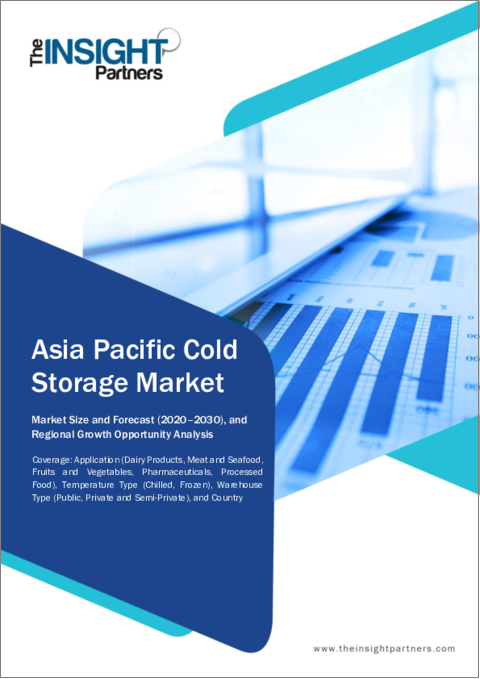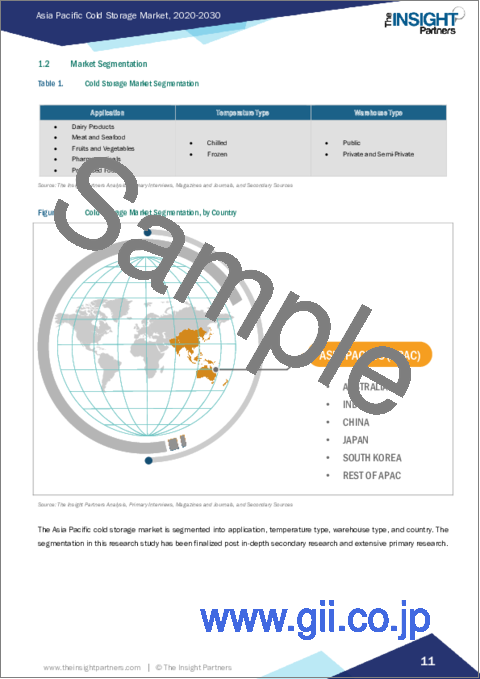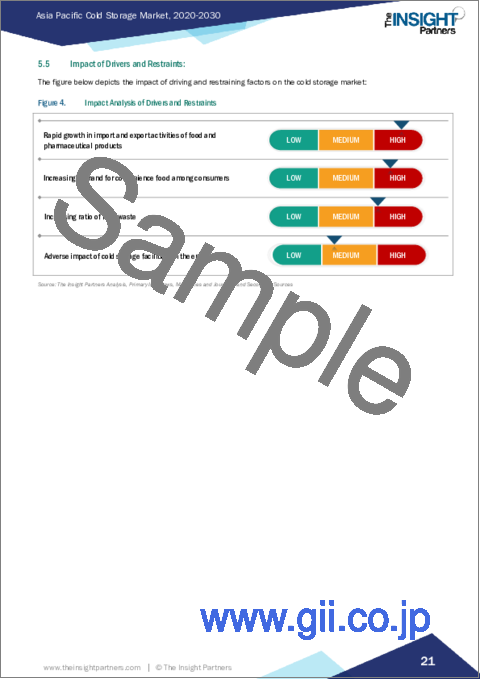|
|
市場調査レポート
商品コード
1592638
アジア太平洋の冷蔵倉庫市場:2030年までの予測 - 地域別分析 - 用途別、温度タイプ別、倉庫タイプ別Asia Pacific Cold Storage Market Forecast to 2030 - Regional Analysis - by Application, Temperature Type, and Warehouse Type |
||||||
|
|||||||
| アジア太平洋の冷蔵倉庫市場:2030年までの予測 - 地域別分析 - 用途別、温度タイプ別、倉庫タイプ別 |
|
出版日: 2024年09月16日
発行: The Insight Partners
ページ情報: 英文 73 Pages
納期: 即納可能
|
- 全表示
- 概要
- 図表
- 目次
アジア太平洋の冷蔵倉庫市場は、2022年には260億1,841万米ドルとなり、2030年までには1,006億6,254万米ドルに達すると予測され、2022年から2030年までのCAGRは18.4%と推定されます。
持続可能な冷凍・貯蔵技術がアジア太平洋の冷蔵倉庫市場を後押し
超臨界CO2システムは、オゾン層破壊係数(ODP)が非常に低い二酸化炭素(CO2)を冷媒として使用します。オゾン層破壊の原因となるハイドロフルオロカーボン(HFC)やハイドロクロロフルオロカーボン(HCFC)といった従来の冷媒とは異なり、CO2はオゾン層を破壊しません。この特性により、低温貯蔵用超臨界CO2冷凍システムは環境にやさしく、オゾン層破壊物質を段階的に削減する世界の取り組みを支援します。超臨界CO2システムは、従来の多くの冷蔵施設と比較して、地球温暖化係数(GWP)が大幅に抑えられています。GWPは、温室効果ガスが一定期間にわたって地球温暖化に影響を与える能力を測定したものです。CO2のGWPは1であるのに対し、冷凍システムで一般的に使用されるHFCのGWPは数千から数万です。CO2を冷媒として使用することで、超臨界圧システムは気候変動を緩和し、冷房・冷蔵アプリケーションの二酸化炭素排出量を削減します。全体として、低温貯蔵トランスクリティカルCO2システムの環境への影響の低さは、世界の環境目標をサポートすることで市場を牽引しています。持続可能な冷凍・貯蔵ソリューションへのニーズが発展し続ける中、蓄冷式超臨界CO2技術は、様々な分野のビジネスに実行可能でスマートな選択肢を提供します。さらに、低温蓄熱技術の応用も環境に優しい貯蔵施設の選択肢の1つであり、予測期間中、低温貯蔵市場に機会を提供することができます。
アジア太平洋の冷蔵倉庫市場の概要
人口の増加、消費者所得の増加、加工食品や缶詰食品への選好の高まりが、低温貯蔵市場にプラスの影響を与えています。近年、コンビニエンス食品や冷凍食品、プロバイオティクス、医薬品、生鮮食品への支出が増加しているため、冷蔵施設の人気と重要性が急上昇しています。食品・飲料、医薬品、化学薬品など、いくつかの業界では製品の保存に冷蔵施設を利用しています。食品業界では、冷凍食品と生鮮食品の需要が高まっているため、製品の鮮度を保ち、腐敗を防ぐために低温貯蔵施設が不可欠となっています。製薬業界では、温度管理されたワクチンや医薬品の有効性を維持するため、冷蔵倉庫に大きく依存しています。
世界化と輸送ロジスティクスの拡大も、様々な製品の国内または国際的なサプライチェーンを後押ししています。この動向は、距離や移動時間に関係なく、必要な温度を保った理想的な状態で製品が消費者に届くようにするため、冷蔵倉庫の需要を向上させています。
オンライン食料品販売とeコマース・プラットフォームの人気の高まりは、パンデミックと社会的な距離感によってさらに増大し、市場の成長に大きく寄与しています。さらに、製品の活発な輸出入を支援する制度や政策を実施する政府の取り組みが拡大していることも、アジア太平洋の冷蔵倉庫市場の成長を後押ししています。
アジア太平洋の冷蔵倉庫市場の収益と2030年までの予測(金額)
アジア太平洋の冷蔵倉庫市場のセグメンテーション
アジア太平洋の冷蔵倉庫市場は、用途、温度タイプ、倉庫タイプ、国別に分類されます。
用途別に見ると、アジア太平洋の冷蔵倉庫市場は、乳製品、肉・魚介類、果物・野菜、医薬品、加工食品に区分されます。肉・魚介類セグメントは2022年にアジア太平洋の冷蔵倉庫市場で最大のシェアを占めました。
温度タイプでは、アジア太平洋の冷蔵倉庫市場はチルドと冷凍に二分されます。2022年のアジア太平洋の冷蔵倉庫市場シェアは冷凍部門が大きいです。
倉庫タイプ別では、アジア太平洋の冷蔵倉庫市場は公営と私営・半私営に区分されます。2022年のアジア太平洋の冷蔵倉庫市場シェアは、公共部門がより大きいです。
国別では、アジア太平洋の冷蔵倉庫市場はオーストラリア、中国、日本、インド、韓国、その他アジア太平洋に区分されます。2022年のアジア太平洋の冷蔵倉庫市場シェアは中国が独占しました。
Nichirei Corp、Americold Realty Trust Inc、Lineage Logistics Holdings LLC、NewCold Cooperatief UAなどがアジア太平洋の冷蔵倉庫市場で事業を展開する主要企業です。
目次
第1章 イントロダクション
第2章 エグゼクティブサマリー
- 主要洞察
- 市場の魅力
第3章 調査手法
- 調査範囲
- 2次調査
- 1次調査
第4章 アジア太平洋の冷蔵倉庫市場情勢
- エコシステム分析
- 生産者
- 保管業者
- エンドユーザー
第5章 アジア太平洋の冷蔵倉庫市場:主要市場力学
- 市場促進要因
- 食品・医薬品の輸出入の急増
- 消費者のコンビニエンス食品需要の増加
- 食品廃棄物の増加
- 市場抑制要因
- 冷蔵施設が環境に与える悪影響
- 市場機会
- 持続可能な冷凍・貯蔵技術
- 今後の動向
- 冷蔵倉庫の自動化
- 促進要因と抑制要因の影響
第6章 冷蔵倉庫市場:アジア太平洋市場分析
- 冷蔵倉庫市場の収益、2022年~2030年
- 冷蔵倉庫市場の予測分析
第7章 アジア太平洋の冷蔵倉庫市場分析:用途別
- 乳製品
- 肉・魚介類
- 果物・野菜
- 医薬品
- 加工食品
第8章 アジア太平洋の冷蔵倉庫市場分析:温度タイプ別
- チルド
- 冷凍
第9章 アジア太平洋の冷蔵倉庫市場分析:倉庫タイプ別
- 公営
- 私営・半私営
第10章 アジア太平洋の冷蔵倉庫市場:国別分析
- アジア太平洋
- オーストラリア
- 中国
- インド
- 日本
- 韓国
- その他アジア太平洋
第11章 業界情勢
- 市場イニシアティブ
- 合併と買収
第12章 企業企業プロファイル
- Nichirei Corp
- Americold Realty Trust Inc
- Lineage Logistics Holdings LLC
- NewCold Cooperatief UA
第13章 付録
List Of Tables
- Table 1. Cold Storage Market Segmentation
- Table 2. Cold Storage Market - Revenue and Forecast to 2030 (US$ Million)
- Table 3. Asia Pacific Cold Storage Market - Revenue and Forecast to 2030 (US$ Million) - by Application
- Table 4. Asia Pacific Cold Storage Market - Revenue and Forecast to 2030 (US$ Million) - by Temperature Type
- Table 5. Asia Pacific Cold Storage Market - Revenue and Forecast to 2030 (US$ Million) - by Warehouse Type
- Table 6. Asia Pacific: Cold Storage Market - Revenue and Forecast to 2030(US$ Million) - by Country
- Table 7. Australia: Cold Storage Market - Revenue and Forecast to 2030(US$ Million) - by Application
- Table 8. Australia: Cold Storage Market - Revenue and Forecast to 2030(US$ Million) - by Temperature Type
- Table 9. Australia: Cold Storage Market - Revenue and Forecast to 2030(US$ Million) - by Warehouse Type
- Table 10. China: Cold Storage Market - Revenue and Forecast to 2030(US$ Million) - by Application
- Table 11. China: Cold Storage Market - Revenue and Forecast to 2030(US$ Million) - by Temperature Type
- Table 12. China: Cold Storage Market - Revenue and Forecast to 2030(US$ Million) - by Warehouse Type
- Table 13. India: Cold Storage Market - Revenue and Forecast to 2030(US$ Million) - by Application
- Table 14. India: Cold Storage Market - Revenue and Forecast to 2030(US$ Million) - by Temperature Type
- Table 15. India: Cold Storage Market - Revenue and Forecast to 2030(US$ Million) - by Warehouse Type
- Table 16. Japan: Cold Storage Market - Revenue and Forecast to 2030(US$ Million) - by Application
- Table 17. Japan: Cold Storage Market - Revenue and Forecast to 2030(US$ Million) - by Temperature Type
- Table 18. Japan: Cold Storage Market - Revenue and Forecast to 2030(US$ Million) - by Warehouse Type
- Table 19. South Korea: Cold Storage Market - Revenue and Forecast to 2030(US$ Million) - by Application
- Table 20. South Korea: Cold Storage Market - Revenue and Forecast to 2030(US$ Million) - by Temperature Type
- Table 21. South Korea: Cold Storage Market - Revenue and Forecast to 2030(US$ Million) - by Warehouse Type
- Table 22. Rest of Asia Pacific: Cold Storage Market - Revenue and Forecast to 2030(US$ Million) - by Application
- Table 23. Rest of Asia Pacific: Cold Storage Market - Revenue and Forecast to 2030(US$ Million) - by Temperature Type
- Table 24. Rest of Asia Pacific: Cold Storage Market - Revenue and Forecast to 2030(US$ Million) - by Warehouse Type
List Of Figures
- Figure 1. Cold Storage Market Segmentation, by Country
- Figure 2. Ecosystem Analysis
- Figure 3. Cold Storage Market - Key Market Dynamics
- Figure 4. Impact Analysis of Drivers and Restraints
- Figure 5. Cold Storage Market Revenue (US$ Million), 2022-2030
- Figure 6. Asia Pacific Cold Storage Market Share (%) - by Application (2022 and 2030)
- Figure 7. Dairy Products: Cold Storage Market - Revenue and Forecast to 2030 (US$ Million)
- Figure 8. Meat and Seafood: Cold Storage Market - Revenue and Forecast to 2030 (US$ Million)
- Figure 9. Fruits and Vegetables: Cold Storage Market - Revenue and Forecast to 2030 (US$ Million)
- Figure 10. Pharmaceuticals: Cold Storage Market - Revenue and Forecast to 2030 (US$ Million)
- Figure 11. Processed Food: Cold Storage Market - Revenue and Forecast to 2030 (US$ Million)
- Figure 12. Asia Pacific Cold Storage Market Share (%) - by Temperature Type (2022 and 2030)
- Figure 13. Chilled: Cold Storage Market - Revenue and Forecast to 2030 (US$ Million)
- Figure 14. Frozen: Cold Storage Market - Revenue and Forecast to 2030 (US$ Million)
- Figure 15. Asia Pacific Cold Storage Market Share (%) - by Warehouse Type (2022 and 2030)
- Figure 16. Public: Cold Storage Market - Revenue and Forecast to 2030 (US$ Million)
- Figure 17. Private and Semi-Private: Cold Storage Market - Revenue and Forecast to 2030 (US$ Million)
- Figure 18. Asia Pacific Cold Storage Platforms Market, by Key Countries - Revenue (2022) (US$ Million)
- Figure 19. Asia Pacific: Cold Storage Market Breakdown, by Key Countries, 2022 and 2030 (%)
- Figure 20. Australia: Cold Storage Market - Revenue and Forecast to 2030(US$ Million)
- Figure 21. China: Cold Storage Market - Revenue and Forecast to 2030(US$ Million)
- Figure 22. India: Cold Storage Market - Revenue and Forecast to 2030(US$ Million)
- Figure 23. Japan: Cold Storage Market - Revenue and Forecast to 2030(US$ Million)
- Figure 24. South Korea: Cold Storage Market - Revenue and Forecast to 2030(US$ Million)
- Figure 25. Rest of Asia Pacific: Cold Storage Market - Revenue and Forecast to 2030(US$ Million)
The Asia Pacific cold storage market was valued at US$ 26,018.41 million in 2022 and is expected to reach US$ 100,662.54 million by 2030; it is estimated to register a CAGR of 18.4% from 2022 to 2030.
Sustainable Refrigeration and Storage Technologies Boost Asia Pacific Cold Storage Market
The application of transcritical CO2 systems uses carbon dioxide (CO2) as a refrigerant, which has a very low ozone depletion potential (ODP). Unlike conventional refrigerants such as hydrofluorocarbons (HFCs) or hydrochlorofluorocarbons (HCFCs), which contribute to ozone layer depletion, CO2 does not damage the ozone layer. This characteristic makes cold storage transcritical CO2 refrigeration systems environmentally friendly and supports global efforts to phase out ozone-depleting substances. Transcritical CO2 systems have a substantially minimalized global warming potential (GWP) compared to many conventional cold storage facilities. GWP measures the ability of greenhouse gases to impact global warming over a definite period. CO2 has a GWP of 1, whereas HFCs commonly used in refrigeration systems have GWPs in the thousands or even tens of thousands. By using CO2 as a refrigerant, transcritical systems help moderate climate change and reduce the carbon footprint of cooling and refrigeration applications. Overall, the low environmental impact of cold storage transcritical CO2 systems are driving the market by supporting global environmental objectives. As the need for sustainable refrigeration and storage solutions continues to develop, cold storage transcritical CO2 technology offers a viable and smart option for businesses across various sectors. Furthermore, the application of cold thermal storage technology is also one of the environment-friendly alternatives for storage facilities that can provide opportunities for the cold storage market over the forecast period.
Asia Pacific Cold Storage Market Overview
The increasing population, rising consumer income, and growing preference for processed and canned food have positively favored the cold storage market. The popularity and importance of cold storage facilities have soared in recent years owing to increased expenditure on convenience and frozen food, probiotics, pharmaceuticals, or fresh produce. Several industries, such as food & beverages, pharmaceuticals, and chemicals, rely on cold storage facilities to preserve their products. In the food industry, the mounting demand for frozen and fresh foods has made cold storage facilities crucial for preserving product freshness and avoiding spoilage. The pharmaceutical industry immensely depends on cold storage to conserve the effectiveness of temperature-controlled vaccines and drugs.
Globalization and expansion in transport logistics have also boosted the supply chain of various products nationally or internationally. This trend has improved the demand for cold storage facilities to make certain that the products reach consumers in ideal condition, preserving a necessary temperature, regardless of distance and time of travel.
The growing popularity of online grocery sales and e-commerce platforms, which were further augmented by the pandemic and social distancing, majorly contribute to the market growth. Furthermore, the growing government initiatives to implement schemes and policies that support vigorous import and export of products are boosting the growth of the cold storage market in Asia Pacific.
Asia Pacific Cold Storage Market Revenue and Forecast to 2030 (US$ Million)
Asia Pacific Cold Storage Market Segmentation
The Asia Pacific cold storage market is categorized into application, temperature type, warehouse type, and country.
Based on application, the Asia Pacific cold storage market is segmented into dairy products, meat and seafood, fruits and vegetables, pharmaceuticals, and processed food. The meat and seafood segment held the largest Asia Pacific cold storage market share in 2022.
In terms of temperature type, the Asia Pacific cold storage market is bifurcated into chilled and frozen. The frozen segment held a larger Asia Pacific cold storage market share in 2022.
By warehouse type, the Asia Pacific cold storage market is segmented into public and private & semi-private. The public segment held a larger Asia Pacific cold storage market share in 2022.
By country, the Asia Pacific cold storage market is segmented into Australia, China, Japan, India, South Korea, and the Rest of Asia Pacific. China dominated the Asia Pacific cold storage market share in 2022.
Nichirei Corp, Americold Realty Trust Inc, Lineage Logistics Holdings LLC, and NewCold Cooperatief UA are some of the leading companies operating in the Asia Pacific cold storage market.
Table Of Contents
1. Introduction
- 1.1 The Insight Partners Research Report Guidance
- 1.2 Market Segmentation
2. Executive Summary
- 2.1 Key Insights
- 2.2 Market Attractiveness
3. Research Methodology
- 3.1 Coverage
- 3.2 Secondary Research
- 3.3 Primary Research
4. Asia Pacific Cold Storage Market Landscape
- 4.1 Overview
- 4.2 Ecosystem Analysis
- 4.2.1 Producers
- 4.2.2 Storage Providers
- 4.2.3 End Users
5. Asia Pacific Cold Storage Market - Key Market Dynamics
- 5.1 Market Drivers
- 5.1.1 Rapid Growth in Import and Export Activities of Food and Pharmaceutical Products
- 5.1.2 Increasing Demand for Convenience Food Among Consumers
- 5.1.3 Rise in Food Waste
- 5.2 Market Restraints
- 5.2.1 Adverse Impact of Cold Storage Facilities on Environment
- 5.3 Market Opportunities
- 5.3.1 Sustainable Refrigeration and Storage Technologies
- 5.4 Future Trends
- 5.4.1 Automation in Cold Storage Facilities
- 5.5 Impact of Drivers and Restraints:
6. Cold Storage Market -Asia Pacific Market Analysis
- 6.1 Cold Storage Market Revenue (US$ Million), 2022-2030
- 6.2 Cold Storage Market Forecast Analysis
7. Asia Pacific Cold Storage Market Analysis - by Application
- 7.1 Dairy Products
- 7.1.1 Overview
- 7.1.2 Dairy Products: Cold Storage Market - Revenue and Forecast to 2030 (US$ Million)
- 7.2 Meat and Seafood
- 7.2.1 Overview
- 7.2.2 Meat and Seafood: Cold Storage Market - Revenue and Forecast to 2030 (US$ Million)
- 7.3 Fruits and Vegetables
- 7.3.1 Overview
- 7.3.2 Fruits and Vegetables: Cold Storage Market - Revenue and Forecast to 2030 (US$ Million)
- 7.4 Pharmaceuticals
- 7.4.1 Overview
- 7.4.2 Pharmaceuticals: Cold Storage Market - Revenue and Forecast to 2030 (US$ Million)
- 7.5 Processed Food
- 7.5.1 Overview
- 7.5.2 Processed Food: Cold Storage Market - Revenue and Forecast to 2030 (US$ Million)
8. Asia Pacific Cold Storage Market Analysis - by Temperature Type
- 8.1 Chilled
- 8.1.1 Overview
- 8.1.2 Chilled: Cold Storage Market - Revenue and Forecast to 2030 (US$ Million)
- 8.2 Frozen
- 8.2.1 Overview
- 8.2.2 Frozen: Cold Storage Market - Revenue and Forecast to 2030 (US$ Million)
9. Asia Pacific Cold Storage Market Analysis - by Warehouse Type
- 9.1 Public
- 9.1.1 Overview
- 9.1.2 Public: Cold Storage Market - Revenue and Forecast to 2030 (US$ Million)
- 9.2 Private and Semi-Private
- 9.2.1 Overview
- 9.2.2 Private and Semi-Private: Cold Storage Market - Revenue and Forecast to 2030 (US$ Million)
10. Asia Pacific Cold Storage Market - Country Analysis
- 10.1 Asia Pacific
- 10.1.1 Asia Pacific Cold Storage Market Overview
- 10.1.2 Asia Pacific: Cold Storage Market - Revenue and Forecast Analysis - by Country
- 10.1.2.1 Asia Pacific: Cold Storage Market - Revenue and Forecast Analysis - by Country
- 10.1.2.2 Australia: Cold Storage Market - Revenue and Forecast to 2030 (US$ Million)
- 10.1.2.2.1 Australia: Cold Storage Market Breakdown, by Application
- 10.1.2.2.2 Australia: Cold Storage Market Breakdown, by Temperature Type
- 10.1.2.2.3 Australia: Cold Storage Market Breakdown, by Warehouse Type
- 10.1.2.3 China: Cold Storage Market - Revenue and Forecast to 2030 (US$ Million)
- 10.1.2.3.1 China: Cold Storage Market Breakdown, by Application
- 10.1.2.3.2 China: Cold Storage Market Breakdown, by Temperature Type
- 10.1.2.3.3 China: Cold Storage Market Breakdown, by Warehouse Type
- 10.1.2.4 India: Cold Storage Market - Revenue and Forecast to 2030 (US$ Million)
- 10.1.2.4.1 India: Cold Storage Market Breakdown, by Application
- 10.1.2.4.2 India: Cold Storage Market Breakdown, by Temperature Type
- 10.1.2.4.3 India: Cold Storage Market Breakdown, by Warehouse Type
- 10.1.2.5 Japan: Cold Storage Market - Revenue and Forecast to 2030 (US$ Million)
- 10.1.2.5.1 Japan: Cold Storage Market Breakdown, by Application
- 10.1.2.5.2 Japan: Cold Storage Market Breakdown, by Temperature Type
- 10.1.2.5.3 Japan: Cold Storage Market Breakdown, by Warehouse Type
- 10.1.2.6 South Korea: Cold Storage Market - Revenue and Forecast to 2030 (US$ Million)
- 10.1.2.6.1 South Korea: Cold Storage Market Breakdown, by Application
- 10.1.2.6.2 South Korea: Cold Storage Market Breakdown, by Temperature Type
- 10.1.2.6.3 South Korea: Cold Storage Market Breakdown, by Warehouse Type
- 10.1.2.7 Rest of Asia Pacific: Cold Storage Market - Revenue and Forecast to 2030 (US$ Million)
- 10.1.2.7.1 Rest of Asia Pacific: Cold Storage Market Breakdown, by Application
- 10.1.2.7.2 Rest of Asia Pacific: Cold Storage Market Breakdown, by Temperature Type
- 10.1.2.7.3 Rest of Asia Pacific: Cold Storage Market Breakdown, by Warehouse Type
11. Industry Landscape
- 11.1 Overview
- 11.2 Market Initiative
- 11.3 Merger and Acquisition
12. Company Profiles
- 12.1 Nichirei Corp
- 12.1.1 Key Facts
- 12.1.2 Business Description
- 12.1.3 Products and Services
- 12.1.4 Financial Overview
- 12.1.5 SWOT Analysis
- 12.1.6 Key Developments
- 12.2 Americold Realty Trust Inc
- 12.2.1 Key Facts
- 12.2.2 Business Description
- 12.2.3 Products and Services
- 12.2.4 Financial Overview
- 12.2.5 SWOT Analysis
- 12.2.6 Key Developments
- 12.3 Lineage Logistics Holdings LLC
- 12.3.1 Key Facts
- 12.3.2 Business Description
- 12.3.3 Products and Services
- 12.3.4 Financial Overview
- 12.3.5 SWOT Analysis
- 12.3.6 Key Developments
- 12.4 NewCold Cooperatief UA
- 12.4.1 Key Facts
- 12.4.2 Business Description
- 12.4.3 Products and Services
- 12.4.4 Financial Overview
- 12.4.5 SWOT Analysis
- 12.4.6 Key Developments
13. Appendix
- 13.1 About The Insight Partners






